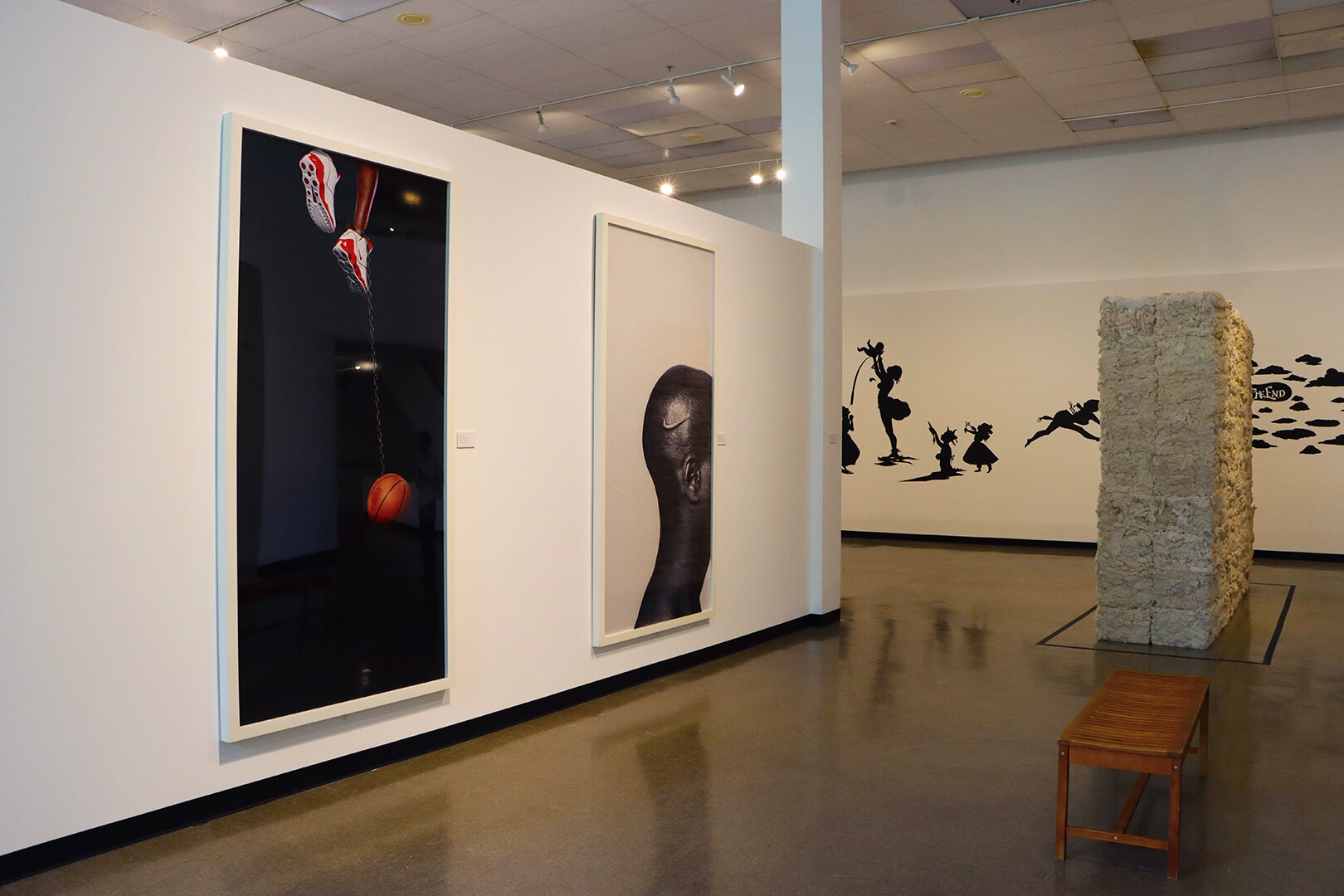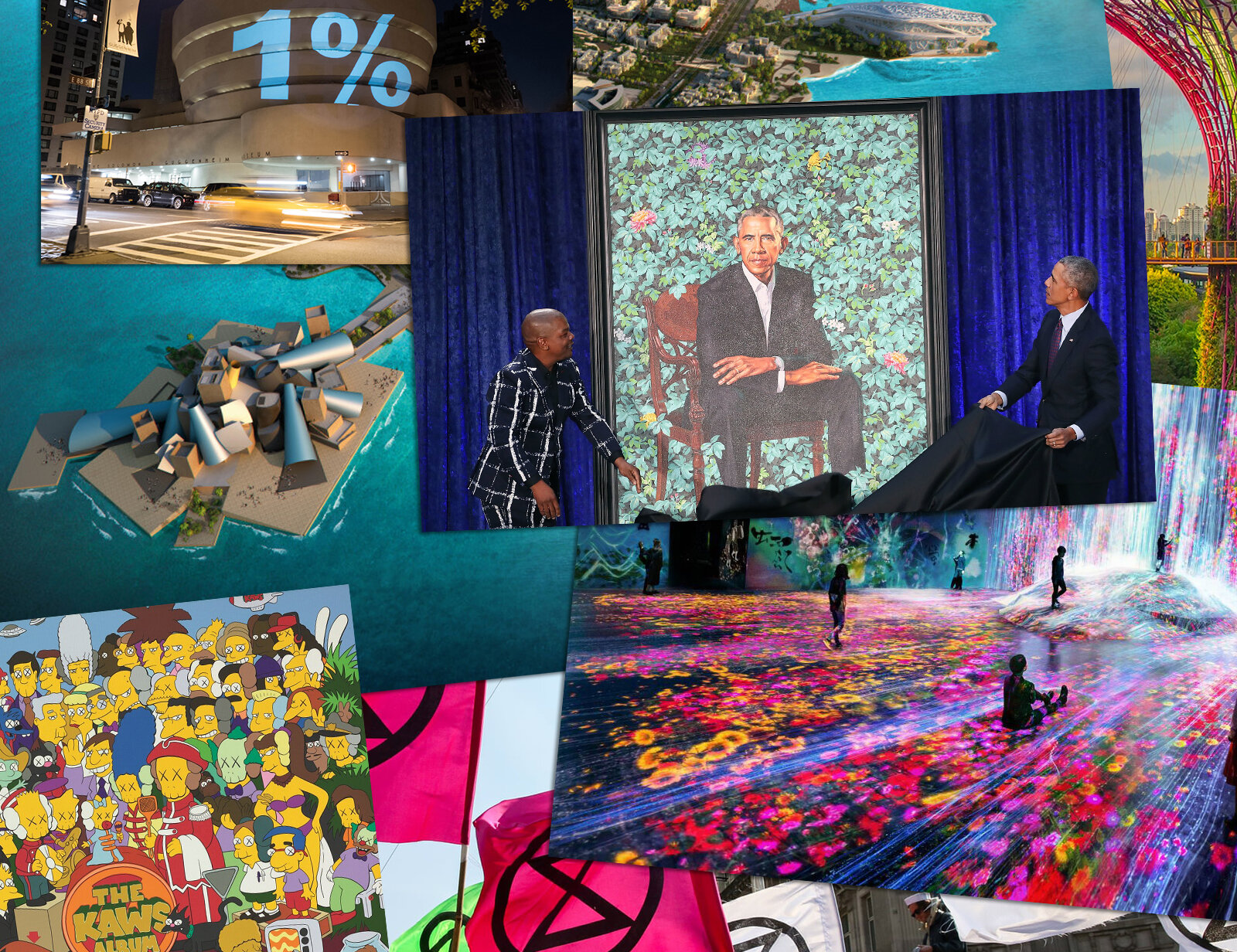Exhibition Review: 30 Americans

The Arlington Museum of Art brings a stunning collection of modern and contemporary art by Black Americans to DFW.
★★★★★
The Arlington Museum of Art in Texas is currently hosting 30 Americans, a stunning selection of works on loan from the Rubell Museum in Miami, featuring art “by many of the most important African American artists of the last three decades.” Viewers will undoubtedly recognize names like Mark Bradford, Kara Walker, Jean-Michel Basquiat, Mickalene Thomas, and Kehinde Wiley.
30 Americans is a very special exhibition. It feels like a once-in-a-lifetime show and yet it has already traveled to eighteen cities across the U.S., following the initial opening in the Rubell Museum in 2008.
I have been eagerly awaiting the exhibition’s arrival since the Museum first teased the collection back in February. Not only does the exhibition bring together the most important African American artists working today but it recognizes these artists as some of the most important American artists of the last thirty years, full stop.
Black culture became mainstream with the election of the first Black President, Barack Obama, the ensuing Black Lives Matter movement, and international protests in response to the police killing of George Floyd.
Furthermore, Black culture has proven profitable for corporations, lead by musicians Beyoncé and Jay-Z, and Hollywood blockbuster hits Get Out (2017) and Marvel’s Black Panther (2018).
Just this week, President Joe Biden signed Juneteenth into law as a federal holiday, commemorating the day Major General Gordon Granger led Union soldiers into Galveston, Texas, in 1865, with news that the Civil War had ended and slavery was abolished.
From slavery to the Civil Rights movement, it’s undeniable that Black history is American history. Curator and Head of African American Art Department at the Detroit Institute of Arts, Valerie Mercer argues, “you can’t just segregate it as being just African-American history.”
The extensive collection on display at the Arlington Museum of Art probes identity and culture through the eyes of Black Americans. Topics range from racism to athleticism, from love to equality.
While major art collections overwhelmingly represent White (85%) and male (87%) artists, 30 Americans presents a diverse grouping of female and also queer artists. 30 Americans offers a great combination of artists, including some that I know and love and artists that I hadn’t previously heard of.
There’s a great mixture of media, including painting, drawing, collage, photography, sculpture, and video. The collection, as notes Milwaukee Art Museum curator Brady Roberts, includes “all of the major trends of contemporary art: abstraction, representation, conceptual, new media, performance, etc., it’s all here.”
Unfortunately, many of the larger works of the original collection are not present, presumably because they simply would not fit into the Arlington Art Museum’s limited space. The three main floors are absolutely full of art.
The shell of a JCPenney department store, the museum can be awkward to navigate, with an unusual layout of load-bearing beams and small rooms. Lighting is inconsistent, varying between natural light from large windows and the artificial glow of fluorescent bulbs. Thankfully, there is plenty of seating offered, and the collection also includes a web app which gives viewers insight into the individual works.
30 Americans is absolutely phenomenal and unmissable. I urge everyone, especially those who may not typically be interested in art exhibits, to visit. View some of the highlights from the collection below.
The Arlington Museum of Art is open Tuesday through Saturday, 10 AM to 5 PM and Sundays from 1 PM to 5 PM. Admission costs $15 for adults, $10 for students and seniors. Children aged 12 and under are free. More information can be found on the museum’s website.
While much of the work in the exhibition tends to focus on subjugation, Kerry James Marshall is not afraid of portraying joy. He laments, “The work of African-American artists has for a long time been seen more as a kind of social phenomena instead of aesthetic phenomena.” In his Vignette series, Marshall rejects the reading of Black art as inherently political to focus on the universality of love.
On the ground floor, approaching the stairs, visitors will find Camptown Ladies by Kara Walker. Known best for her large-scale paper silhouettes, Walker has gained notoriety for her anachronistic portrayals of slavery and the ongoing trials of Black Americans, which conflate the past and present.
On the left, a male jockey sits on the back of a women, enticing her with a carrot. Walker takes the work’s title from Stephen Foster’s 19th century minstrel song Camptown Races, inspired by settlements outside cities where Black laborers raced their work horses.
Whore in the Church House is an abstracted map of South Los Angeles, Mark Bradford’s hometown. Bradford worked as a hair dresser, an experience which informs his artistic practice. The complex textures Bradford creates are made with paint, water, and found materials which he applies and distresses. He describes his process as “archaeology”.
“Sweating like a whore in church” is a Southern saying expressing nervousness. A gay Black man himself, perhaps the phrase is a reference to Bradford’s own experiences with sexuality and Christianity. “If you’re black, you’re born into religion,” he states.
Photographs by Hank Willis Thomas raise questions about athleticism, consumerism, and capitalism. Thomas investigates the commodification of Black bodies within the commercialized realm of sport, a rare industry which allows African-Americans tremendous success while placing a demanding toll on their bodies.
Two prints are included by Glenn Ligon, inspired by his 1988 painting in reference to the iconic “I Am a Man” protest poster carried by striking Black sanitation workers in 1968.
According to Jesse Epps, a union organizer sent to Memphis by the American Federation of State County and Municipal Employees, the poster “was a collaboration of union officials and civil rights activists”. The words were inspired by the Declaration of Independence: “We hold these truths to be self-evident, that all men are created equal.”
Ligon juxtaposes a reproduction of his 1988 painting with a condition report annotated by a conservator. The noted imperfections draw attention to the frailty of the idea of equality itself.
On the second floor is a triptych by Kehinde Wiley, who visitors may know as the painter of President Barack Obama’s official portrait. The grouping is gorgeous, and frankly worth the price of admission alone.
“Wiley’s baroque paintings, in which contemporary African American men are interpolated into sumptuously detailed and meticulously painted canvasses that make reference to some of the most theatrical paintings in the Western “white” canon, suggest a willingness to surf above the complicated history of racial identity, parodying, borrowing and subverting at will,” writes art critic Philip Kennicott for the Washington Post.
There is one work by the late Jean-Michel Basquiat, one of the most important artists of the Pop art movement. The small painting here is one of his few self-portraits, which pays homage to his impressive legacy. Basquiat died of a heroin overdose at the age of 27.
Basquiat skillfully merged art history, pop culture, and the Black experience into his work. Born in Brooklyn to Haitian and Puerto Rican parents, his art investigated slavery, colonialism, as well as Black contributions to music and poetry. In 2017, Basquiat became the most expensive American artist ever sold at auction upon the sale of a 1982 work for $110.5 million.
There’s a series of collages by Kenyan-American artist Wangechi Mutu whose stardom has risen considerably in the past few years. Commissioned by the Metropolitan Museum of Art in New York, Mutu recently created a series of four sculptures for the institution. One of which, The Seated III, is on view nearby, at the Fort Worth Modern.
For The Evolution of Mud Mama from Beginning to Start, Mutu combines watercolor, gold leaf, and clippings to depict the female figure. The deformed shapes raise questions about femininity, beauty, and resilience. Observes Mutu, “Women’s bodies are always at the front of so much of the expression, the hostility, the magnificence of how humankind sees itself.”
WARNING: The following work evokes lynchings and may prove disturbing. Viewer discretion is advised.
Gary Simmons’ disturbing Duck, Duck, Noose is hidden away on the top floor. The controversial work has sparked backlash when previously on display. According to the Arlington Museum of Art, “The rooftop is only accessible by elevator which will ensure that no visitor stumbles upon the piece who has not chosen to view it.”
Nine white Ku Klux Klan hoods sit on stools arranged in a circle around a hanging rope, tied in a noose. The White supremacist group — which is still officially active in nearly half of the nation — has a long history of terrorizing and murdering Black Americans. By comparing lynching to a children’s game, Simmons raises themes of innocence, community, and death. “I struggle not just to engage but to haunt the viewer,” he explains.















